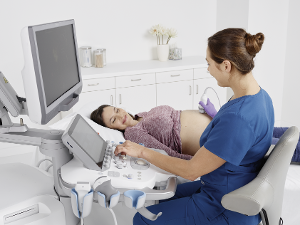
Today's ultrasound technology is truly remarkable. In the past 24 years that I’ve practiced, I’ve seen ultrasound improve by leaps and bounds in its capabilities and potential to improve patient care. Contrast enhanced ultrasound, tissue harmonic imaging, elastography and other technologies have revolutionized how we see inside the human body and make diagnoses.
What hasn't changed in more than two decades is that sonographers are still getting hurt performing their craft.
Now, I don’t mean to say that manufacturers haven't made strides in making ultrasound equipment more ergonomically friendly. More machines have control panels that turn side-to-side and up-and-down, and our tables are more adjustable than ever before. But we're still not quite there yet; sonographers are still scanning in pain.
Portables are becoming even more common as hospitals grow and split departments into elegant outpatient centers and in-patient programs that are completely mobile. And how many sonographers still don’t take the time to change the table height?
There is a physical cost to work-related musculoskeletal disorders (WRMSKD), and there is a financial cost as well. For example, a height-adjustable stretcher can cost $7,000. Without one, a sonographer can easily injure his/her back and miss 12 weeks or more of work—at the cost of $40,000 for a temp to be hired, plus potential disability payments and lost productivity.
What simple steps can be taken to prevent a lifetime of pain? Assuming your workplace is providing you with modern, ergonomic machines and adjustable tables, what else is at your disposal? Do you have anti-fatigue mats? Elbow straps to relieve the weight of the cord? A helper so you are not lifting alone, especially on nights and weekends? If you are not comfortable evaluating your workspace to help prevent injury, have your institution’s risk management or rehab medicine department for help. They will make suggestions that may help reduce risk.
Here are some key points about ergonomics to help you reduce the risk of injury:
-
Get close to the patient. Raise or lower the bed height as necessary and move the patient closer to you on the stretcher.
- Take time to set up your environment. Position the monitor so you can see it without craning your neck, and adjust the control console to a suitable position.
- Try not to extend your arm too much. If possible, go to the other side of the patient to scan and have a helper (or use technology) to freeze and store the image.
- Take care of yourself. Smoking, poor diet and lack of sleep can contribute to a musculoskeletal injury.
Although ultrasound is an inherently non-ergonomic profession, that does not mean that you are doomed to injury. Proper lifting techniques, proper height adjustments and trying to minimize awkward body positioning can help take some of the stress off of your body.
In addition, newer technologies like cordless transducers will also help eliminate some of the reaching and leaning that only a ballerina would enjoy. The most important thing besides taking care of patients is to take care of yourself. Do that, and you can enjoy a long, healthy ultrasound career.
Looking for additional tips to improve ultrasound ergonomics? Subscribe to our blog today!
Sources:
- Sound Ergonomics. (2007). Top 10 List for Sonographers. Retrieved from soundergonomics.com.
- Bailey, J.E., Barnett, J., Baldwin, J., DiGiacinto, D., & Anderson, M.P. (2017). On-the-job pain and injury as related to adaptive ergonomic equipment in the sonographer’s workplace and area. JDMS. 33(1): 15-21.
- Harrison, G., & Harris, A. (2015). Work-related musculoskeletal disorders in ultrasound: Can you reduce risk? Ultrasound. 23: 224-230.






Comments